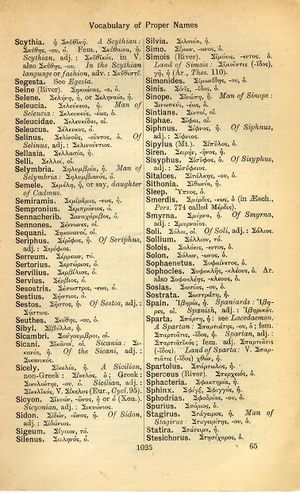Sphinx: Difference between revisions
ἀρχὴν μὲν μὴ φῦναι ἐπιχθονίοισιν ἄριστον· φύντα δ' ὅμως ὤκιστα πύλας Ἀίδαο περῆσαι → First, it is best for mortals to not be born. If born, to pass through Hades' gates as soon as possible.
(6_15) |
m (Text replacement - "]]>" to "]]") |
||
| Line 3: | Line 3: | ||
}} | }} | ||
{{Lewis | {{Lewis | ||
|lshtext=<b>Sphinx</b>: ngis (Gr.<br /><b>I</b> gen. Sphingos, Stat. Th. 1, 66), f., = [[Σφίγξ]] | |lshtext=<b>Sphinx</b>: ngis (Gr.<br /><b>I</b> gen. Sphingos, Stat. Th. 1, 66), f., = [[Σφίγξ]].<br /><b>I</b> A [[fabulous]] [[monster]] [[near]] [[Thebes]] [[that]] used to [[propose]] riddles to travellers, and [[tear]] in pieces those [[who]] could not [[solve]] [[them]]; [[usually]] represented [[with]] the [[head]] of a [[woman]] and the [[body]] of a [[lion]], [[afterwards]] also [[with]] the wings of a [[bird]]; or, also, [[with]] the [[head]] of a [[man]] and the [[body]] of a [[lion]], Plin. 36, 12, 17, § 77 sqq.; Aus. Idyll. 11, 40; Sen. Phoen. 119; id. Oedip. 92; Stat. Th. 1, 66; Plaut. Poen. 1, 3, 35; Hyg. Fab. 67 al.—[[Augustus]] had the [[figure]] of a sphinx [[upon]] his [[seal]], as a [[symbol]] of [[silence]], Suet. Aug. 50; Plin. 37, 1, 4, § 10.—Plur.: [[pedes]] formati in speciem sphingum, Fest. s. v. [[picati]], p. 206.— In a [[lusus]] verbb., Quint. 6, 3, 98.—<br /><b>II</b> A [[species]] of [[ape]], perh. the chimpanzee, Plin. 8, 21, 30, § 72; Mel. 3, 9; Sol. 27 fin.> | ||
}} | }} | ||
Revision as of 09:30, 13 August 2017
English > Greek (Woodhouse)
Σφίγξ, Σφιγγός, ἡ.
Latin > English (Lewis & Short)
Sphinx: ngis (Gr.
I gen. Sphingos, Stat. Th. 1, 66), f., = Σφίγξ.
I A fabulous monster near Thebes that used to propose riddles to travellers, and tear in pieces those who could not solve them; usually represented with the head of a woman and the body of a lion, afterwards also with the wings of a bird; or, also, with the head of a man and the body of a lion, Plin. 36, 12, 17, § 77 sqq.; Aus. Idyll. 11, 40; Sen. Phoen. 119; id. Oedip. 92; Stat. Th. 1, 66; Plaut. Poen. 1, 3, 35; Hyg. Fab. 67 al.—Augustus had the figure of a sphinx upon his seal, as a symbol of silence, Suet. Aug. 50; Plin. 37, 1, 4, § 10.—Plur.: pedes formati in speciem sphingum, Fest. s. v. picati, p. 206.— In a lusus verbb., Quint. 6, 3, 98.—
II A species of ape, perh. the chimpanzee, Plin. 8, 21, 30, § 72; Mel. 3, 9; Sol. 27 fin.>

